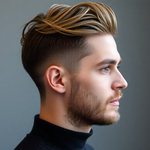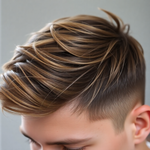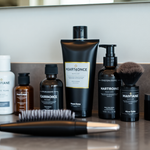
Hue-Driven Minimalism: Build a Low-Waste Men's Capsule Wardrobe with Semi-Permanent Hair Color
03 September 2025
Share
Hook — sharpen your look with less
Hue-Driven Minimalism is the cheat code for guys who want to look put-together without a closet full of junk. Struggling to feel confident in fewer pieces? This guide shows how a tight color strategy paired with semi-permanent hair color amplifies impact, reduces waste, and simplifies daily decisions. Read on for concrete steps, seasonal capsules, color science, and upkeep routines you can start this weekend.
Hue-Driven Minimalism — what it means and why it works
Hue-Driven Minimalism centers your men’s capsule wardrobe around a compact base palette plus one or two deliberate accent hues, and ties those accents to a semi-permanent hair color. The result: a cohesive visual identity that makes fewer garments look like more, reduces impulse buying, and cuts textile waste.
- Decision simplicity: same palette, faster outfit choices.
- Visual coherence: hair color becomes an accessory that elevates minimal pieces.
- Environmental wins: buy less, choose durable fabrics, repair more.
Who benefits most
This approach fits men aged 18–45 who juggle work and social lives, want to express personality through color, and prefer practical sustainability over fashion theater. Whether you’re a young professional, creative, or budget-conscious guy, a hue-driven capsule makes everyday style easier and more intentional.
How to pick your palette: practical color theory
Start with three base colors and one accent hue. The bases cover the core outfit types; the accent adds personality and cohesion with your hair color.
- Choose base neutrals: pick two dark neutrals (navy, charcoal) and one warm neutral (olive, camel, or beige). Dark neutrals hide wear and scale across formality levels.
- Pick an accent hue: choose one saturated but muted color — teal, burgundy, burnt orange, or forest green. Muted saturation reads well day-to-day and pairs with multiple base neutrals.
- Consider your skin tone: cool skin tones suit teal, blue, and berry shades; warm tones look great with burnt orange, mustard, and olive accents.
- Map accent placement: use accent color sparingly on tees, beanies, socks, or lining details to keep the capsule flexible.
Building a low-waste men’s capsule wardrobe: step-by-step
Follow this plan to create a functional capsule of 12–16 items that covers most occasions.
- Audit your current closet (1 hour): Photograph outfits you wear regularly. Keep items you loved in the last 6 months and that fit your chosen palette. Toss or donate anything stained, missized, or unused for over a year.
- Define role pieces (2–3 items): Identify your core outerwear (jacket, coat) and footwear — these shape most outfits.
- Add versatile bases (5–8 items): dark jeans, tailored trousers, a button shirt, two tees (neutral + accent), a knit, and a pair of shorts or lightweight pants.
- Choose one statement piece: a colored knit or accent jacket that reflects your semi-permanent hair color and elevates simple outfits.
- Limit accessories: one watch, one belt, one hat/scarf in the accent color to tie looks together.
- Buy thoughtfully: prefer durable fabrics and ethical brands, repairable design, and classic cuts that won’t date quickly.
Sample 12-piece capsule (season-neutral)
- 1 heavyweight jacket (navy)
- 1 lightweight coat (camel or olive)
- 1 pair dark jeans
- 1 pair tailored chinos (charcoal)
- 1 white button-up
- 1 neutral tee (grey)
- 1 accent tee (teal or burgundy)
- 1 knit sweater (neutral)
- 1 casual sneaker (versatile color)
- 1 pair boots (brown or black)
- 1 belt
- 1 accessory in accent color (beanie/scarf)
Selecting a semi-permanent hair color that complements your capsule
Semi-permanent hair color is ideal for this method — it fades gradually without aggressively altering hair structure. Use hair color to echo your accent hue or to add a neutralizing tone that makes your bases pop.
- Accent match: If your accent is teal, a deep teal tint on hair ends or a subtle all-over teal wash works. For burgundy accents, choose a soft burgundy deposit.
- Subtle wash: Low-dose pigments (a shade or two) add depth without demanding constant maintenance.
- Placement: Consider tips, undercuts, or a light root-to-midshaft glaze for low-maintenance updates.
How to pick the right semi-permanent formula and application
- Choose the formula: look for ammonia-free, low-alkaline semi-permanent dyes or color-depositing conditioners. These minimize damage and usually rinse over 4–12 washes.
- Strand test: always test a small section to check how the pigment shows on your base color.
- Professional vs DIY: book a professional for your first application to get the blending and saturation right. After that, DIY refreshes are usually fine with a deposit mask or pigment conditioner.
- Aftercare: use sulfate-free shampoo, cold water rinses, and a weekly color-depositing mask. Avoid daily hot styling to preserve color longer.
Maintenance schedule: minimize touch time, maximize impact
- Weekly: color-depositing mask and a leave-in conditioner.
- Every 2–4 weeks: quick root/fade touch or at-home deposit mask to refresh hue.
- Monthly: closet check — repair, remove pieces outside the palette, consider one swap if needed.
- Quarterly: deep-clean and evaluate wear on footwear and outerwear; resoling or replacing high-wear items extends lifespan.
How Hue-Driven Minimalism saves money and reduces waste
Two simple math examples:
- Instead of buying 20 mid-range tees at $25 each over two years ($500), buy 6 high-quality tees at $40 each ($240). Higher upfront cost, lower turnover, less landfill risk.
- Repairing a pair of shoes (resoling $60) keeps them wearable for years versus replacing shoes at $80–120 every season.
Small fixes add up — you’ll spend less over time and keep fewer items out of the waste stream.
Seasonal capsule variants: winter, spring/summer, and transitional
Shift two or three items per season to adapt the capsule and keep the look fresh while keeping total inventory low.
- Winter: heavier coat, wool knit, insulated boots.
- Spring/Summer: lightweight jackets, breathable linens, shorts, and low-cut sneakers.
- Transitional: add a midweight overshirt and swap to lighter knits.
Styling formulas to memorize (repeatable, fail-safe combos)
- Smart Casual: Jacket + button shirt + chinos + boots.
- Casual Weekend: Accent tee + jeans + sneakers + lightweight jacket.
- Night Out: Knit sweater + dark trousers + clean sneakers.
- Creative Office: Neutral shirt + accent accessory + tailored trouser + casual blazer.
Practical care and repair kit for low-waste living
- Sewing kit: needles, thread (black, navy, tan), spare buttons.
- Shoe care: brush, neutral/black polish, resoling kit info.
- Laundry: gentle detergent, color-depositing mask, mesh wash bags for delicates.
- Grooming: sulfate-free shampoo, color-safe conditioner, small container of color-deposit mask for touch-ups.
Buying guide: what to prioritize
- Fabric durability over flash: heavier weaves, tighter knits, reinforced seams.
- Neutral fit: not too skinny, not too baggy — your silhouette should be comfortable and tailored enough to look intentional.
- Repairability: avoid bonded hems and glued soles that are hard to fix.
- Transparency: proven supply chain and sustainability practices where possible.
Integrating Menll.com values and products
If you want ready-made, durable staples that fit a sustainable capsule, check Menll.com’s outerwear collection — their durable jackets pair well with palette-led wardrobes and are designed to last. For everyday footwear that balances comfort and conscience, Menll.com’s EcoSneak Casual Shoes are a solid pick to anchor casual looks without sacrificing sustainability.
Real-life examples and scenarios
Scenario A — Young professional, city life: You work in a creative office and want one wardrobe for commute, client drinks, and weekends. Your palette: navy, charcoal, olive base + burgundy accent. You choose a navy jacket, olive chinos, dark jeans, a burgundy tee, a neutral knit, and two pairs of shoes. A burgundy semi-permanent tint on hair tips ties in with your accent — when you walk into meetings, you look intentional without seeming flashy.
Scenario B — University student, limited budget: Your goal is maximum versatility for minimal spend. Pick charcoal, beige, and black bases with a teal accent. Buy a quality dark jean, a neutral hoodie, one accent tee, a multipurpose jacket, and sneakers. A low-dose teal deposit conditioner gives your hair an edge for social scenes without costly salon work.
Evidence & further reading
Textile waste and extended product lifetimes are documented by authoritative sources — for an overview of textiles data and the benefits of reuse and repair, see the EPA's textiles material data page at EPA textiles data. Practical studies on circular fashion and the benefits of long-life garments support choosing durability over fast rotation.
Troubleshooting common problems
- My hair color fades too fast: switch to colder water, use color-depositing masks, and avoid daily washing.
- Capsule feels boring: rotate the placement of your accent (socks, inner lining, pocket squares) and swap one seasonal statement piece each month.
- Shoes show wear quickly: invest in resoling and routine care; a single resoling can double a shoe's life.
Long-term habits that make Hue-Driven Minimalism sustainable
- Buy with a 3-year mind: think how often you'll wear it and whether it needs repairs after one season.
- Set a 'one-in, one-out' rule to keep your collection tight.
- Document outfits you love — a photo folder saves you from repeating mistakes.
- Swap or rent statement pieces for special events rather than buying.
Final checklist — start this weekend
- Audit and photograph your wardrobe.
- Pick base palette and one accent hue (write them down).
- Choose a semi-permanent hair color that matches or complements the accent; book a consult or buy a strand test.
- Buy one high-impact, durable piece (jacket or shoes) to anchor the capsule. Check Menll.com’s outerwear collection for durable options.
- Create a monthly maintenance routine: laundry, repairs, and color touch-up day.
Parting shot
Hue-Driven Minimalism lets you control how you present yourself with purpose. A tight, durable capsule and a thoughtful semi-permanent hair color give you more confidence, fewer choices, and a smaller environmental footprint. Try it for one season — keep what works, and ditch the rest.
Call to action
Which accent hue are you testing first — teal, burgundy, or burnt orange? Drop a comment below and browse Menll.com’s outerwear collection to find a durable anchor piece for your new capsule.
Prev post

Semi-Permanent Hair Color as a Closet Strategy: Build a Sustainable Men's Capsule Wardrobe
Updated on 04 September 2025
Next post

Seasonal Palette Switch: Use Semi‑Permanent Hair Color to Refresh a Sustainable Men's Capsule Wardrobe
Updated on 02 September 2025





